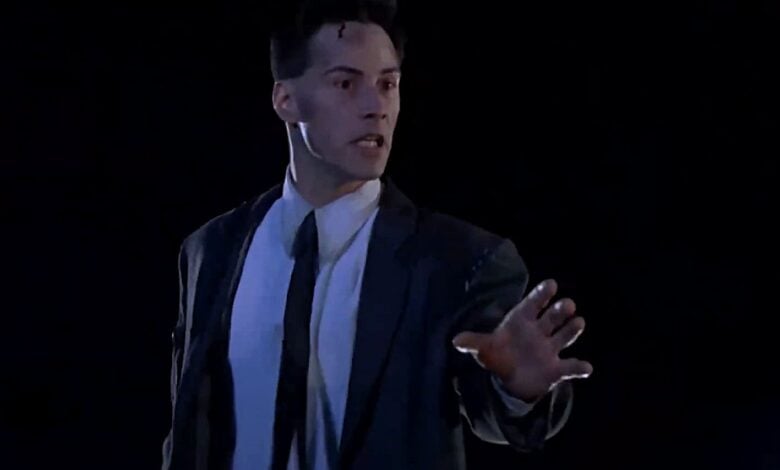
Robert Longo’s “Johnny Mnemonic” (1995) was considered an outright disaster upon its summer of 1995 release.
Now, it’s something of a cult favorite, not only because its new black and white version is preferred among its fanbase but because it has yet another Keanu Reeves performance that has aged far better than expected.
That’s not to say the movie is good, only that the entertainment value and an appreciation of Reeves’ most infamous scene (I’ll get to that shortly), have increased over time.
Reeves is so robotic as the title character, it comes as a surprise when we learn he isn’t playing a robot or android. Johnny is a high-tech courier in a futuristic world of 2021 where, rather than send something via e-mail on the internet (concepts the film seems aware of but doesn’t fully broach), he inserts information into his brain, which serves as a hard drive.
What happens to all the other memories he holds? Johnny helpfully explains to us, “I had to dump a large chunk of long-term memory … my childhood.”
When Johnny is given an especially valuable piece of information, hit men are sent to decapitate him. All of this is accompanied by a cool soundtrack by artists like Stabbing Westward, Bono and the Edge, Buckethead and Orbital, though the songs are better heard on the soundtrack than the barely-there way they float through the movie.
Longtime readers know how much I like Reeves, but his performance here isn’t great, to put it nicely. The film itself is a missed opportunity but a fascinating one. It’s a rare case of cyber-genius author William Gibson translating his vision to the big screen.
Despite Gibson authoring the screenplay (based on one of his stories), acclaimed artist Longo directing and sporting a most unusual cast, “Johnny Mnemonic” remains a fascinating, visually arresting and fatally goofy failure.
Reeves is often very funny as Johnny, occasionally on purpose, but mostly because his amusingly wooden acting and the silly dialog combine to make a perfect storm of an enjoyably bad performance.
In the 1995 film Johnny Mnemonic, the eponymous character (Keanu Reeves) was a data courier with a brain implant that could hold 80GB of data.
A few days back, I picked up this Lexar 512GB JumpDrive for $39.95 and didn’t have to sacrifice my childhood memories like Johnny did. pic.twitter.com/vkzu5LAA9l
— Clayton Hove (@adtothebone) February 18, 2024
The computer graphic imagery still looks cool, whether it’s Johnny conducting a hack with VR headgear and what looks like a Nintendo Power Glove, or the all-out, “TRON”-like finish. Even though this was made in the age of CD-ROMs, and “the net” was still in its infancy (but is referenced enough to suggest Gibson’s understanding of its potential), it’s fun to see the 1995 cyber punk idea of 2021 technology.
As if the camp value wasn’t already intact, there’s Dolph Lundgren’s performance as The Preacher, a long haired assassin who spouts religious-themed one-liners the way Arnold Schwarzenegger’s Mr. Freeze is full of “ice” puns in “Batman & Robin” (1997).
This came out the same year as “The Net” and “Hackers,” all of which paint a distinctly ’90s vision of computer hacking and techno awareness as dated as a dusty old copy of Wired Magazine. Gibson’s prophetic warnings of “information overload” are intriguing but don’t fully come across.
Takeshi Kitano has a supporting role as a charismatic assassin; Kitano’s part was much bigger in the film’s longer overseas release and is partially restored in the newer, preferred version. Even with a cast that includes Dina Meyer (who exhibits real movie star presence), Udo Kier, Ice-T (looking as silly here as he was in “Tank Girl” the same year) and Henry Rollins, this is less playfully quirky than conceptually messy.
Take away the star power and flashy effects, and it’s as grungy and under-lit as those 1980s Golan/Globus sci-fi productions from Cannon Films.
Longo clearly gets the value of textured art direction but aiming for Terry Gilliam visuals doesn’t work if there isn’t a human center at the core. The computer graphics are every bit as hyper-stylized and cool-looking as those in “The Lawnmower Man” (1992) and “Disclosure” (1994) and provide a temporary distraction from how bad the film is.
Yet, it’s hard to resist a movie with a mystical, hardwired dolphin, a literal “ghost in the machine” and Reeves’ immortal “I Want Room Service” monolog. The latter was reportedly due to Reeves having had just played Hamlet (in an acclaimed performance on the Canadian stage) and wanting a beefy bit of dialog.
I’m glad the Bard inspired Reeves, as his late-in-the-movie bit about wanting a “$10,000.00 a night hooker” is funnier than most of his performances in actual comedies.
An audacious cult favorite, JOHNNY MNEMONIC (1995)—starring Keanu Reeves—is a roller coaster of action and high-impact imagery.
As part of our AI collection, we’re presenting the Exclusive Streaming Premiere of a black-and-white version of the film. https://t.co/KbIup3Er45 pic.twitter.com/MOoULIJuxe
— Criterion Channel (@criterionchannl) July 3, 2023
Bad movies can be fun, as this one most definitely is. Reeves had no luck with this instant box office flop, nor playing another John (Jonathan Harker) in “Bram Stoker’s Dracula” (1992), where he was the weak link in an otherwise brilliant film.
Reeves’ performance as John Constantine in 2005 was, likewise, not widely loved until the film developed a better reputation a decade or so later. The actor hit upon a winner with “John Wick” (2014).
I’d also argue that his all-time best performance playing a “Johny” can be found in “Point Break” (1991), where he plays Johnny Utah. If this seems like a silly thing to ponder, just try watching “Johnny Mnemonic,” with its talking dolphin and Lundgren-gone-wild.
I have to hand it to Reeves – his best movies are genuinely terrific, while his bad ones, in hindsight, are proving to be more fun than expected.
